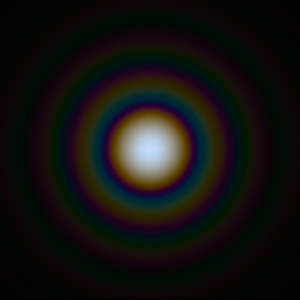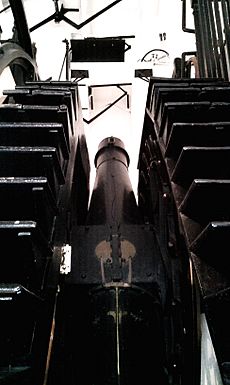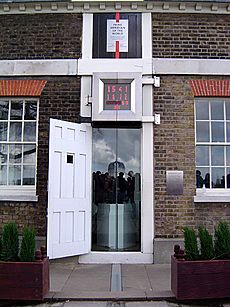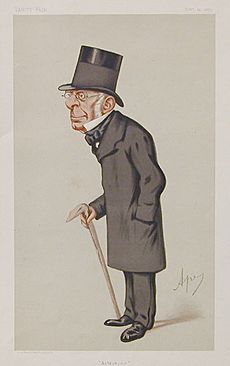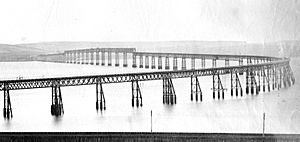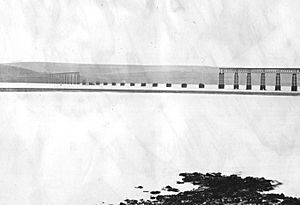George Biddell Airy facts for kids
Quick facts for kids
George Biddell Airy
|
|
|---|---|
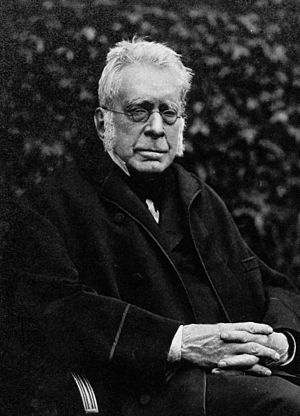
George Biddell Airy in 1891
|
|
| Born | 27 July 1801 Alnwick, Northumberland, England
|
| Died | 2 January 1892 (aged 90) Greenwich, London, England
|
| Nationality | British |
| Education | Colchester Royal Grammar School |
| Alma mater | Trinity College, Cambridge |
| Known for | Seventh Astronomer Royal See full list |
| Awards | Smith's Prize (1823) Copley Medal (1831) RAS Gold Medal (1833, 1846) Lalande Prize (1834) Royal Medal (1845) Albert Medal (1876) |
| Scientific career | |
| Fields | Astronomy, mathematics |
| Institutions | Trinity College, Cambridge Royal Society |
| Academic advisors | George Peacock |
Sir George Biddell Airy (born July 27, 1801 – died January 2, 1892) was an English mathematician and astronomer. He became the seventh Astronomer Royal from 1835 to 1881. This was a very important job in British science.
Airy achieved many things. He studied how planets move. He also measured the Earth's average density. He helped set up Greenwich as the place for the prime meridian. This is the starting line for measuring longitude around the world.
Contents
About George Biddell Airy
George Biddell Airy was born in Alnwick, England. His family had been farmers for a long time. As a child, he went to elementary schools in Hereford and then to Colchester Royal Grammar School. He was a quiet child. But he became popular by being very good at making peashooters!
When he was 13, Airy often stayed with his uncle, Arthur Biddell. His uncle introduced him to Thomas Clarkson. Clarkson was famous for trying to end the slave trade. Clarkson had studied mathematics at Cambridge University. He tested Airy's knowledge. Because of this, Airy went to Trinity College, Cambridge in 1819. He was a "sizar," which meant he paid less for college. In return, he worked like a servant.
Airy was very successful at Cambridge. He was soon seen as the best student in his year. In 1822, he became a scholar of Trinity. The next year, he graduated as the top mathematics student. He also won the first Smith's Prize. In 1824, he became a fellow of Trinity. In 1826, he was made the Lucasian Professor of Mathematics. This is a very famous position. He held it for just over a year. In 1828, he became the professor of astronomy. He also directed the new Cambridge Observatory.
In 1836, he became a member of the Royal Society. This is a group for important scientists.
Airy's Scientific Work
Airy wrote many papers on math and physics. He was very active in his early career. At the Cambridge Observatory, he quickly showed he was a great organizer. When he took over, there was only one main telescope. He worked hard to use it well. He made sure all observations were recorded and published on time. This amazed other scientists.
He also helped install a new telescope. It was a 12-inch telescope given by the Duke of Northumberland. This telescope was finished after Airy moved to Greenwich in 1835.
Airy's early writings were about math, physics, and astronomy. He studied how light bends, called "diffraction." He also explained the full theory of the rainbow. For this work, he won the Copley Medal in 1831. In astronomy, he studied the mass of Jupiter. He also found a new pattern in the movements of Earth and Venus.
Measuring Earth's Density
One of Airy's most amazing studies was finding the Earth's average density. In 1826, he thought of an idea. He would use pendulums at the top and bottom of a deep mine. His first try failed. A second try in 1828 also failed because the mine flooded.
Many years later, in 1854, he tried again. This time, the experiments happened at the Harton pit in northern England. He found that gravity was stronger at the bottom of the mine. It was stronger by a small amount. From this, he calculated the Earth's density to be 6.566 times the density of water. Today, we know the Earth's density is about 5.5153 grams per cubic centimeter. Airy's careful work was very important for its time.
Planets and Their Movements
Airy found a new pattern in how Venus and the Earth move. This was a very important discovery. He noticed that 13 times the speed of Venus is almost equal to 8 times the speed of Earth. This small difference causes a noticeable change over 240 years.
This study was one of the hardest ever done in planetary theory at that time. It was the first big improvement in how we understood the Sun's movements in England. For this work, he won the Gold Medal of the Royal Astronomical Society in 1833. He won it again in 1846.
The Airy Disk
When you look through a telescope, even a perfect one, a star doesn't look like a tiny point. Instead, it looks like a bright spot with rings around it. This pattern is called the Airy disk. It happens because of how light behaves, called "diffraction." The size of this disk depends on the light's color and the telescope's opening.
Before Airy, some people thought stars looked like big disks. This made them think stars were much, much bigger than the Sun. But Airy explained that these disks were not real images of the stars. They were just the Airy disks caused by the telescope itself. This helped scientists understand that stars are actually very far away and appear as tiny points of light through modern telescopes.
Astronomer Royal at Greenwich
In June 1835, Airy became the Astronomer Royal. This was a very important job at the national observatory in Greenwich. When he started, the observatory was not in good shape. Airy worked very hard to fix everything. He changed how observations were recorded. He organized the library. He also set up new telescopes and a magnetic observatory.
In 1850, a large new telescope called the transit circle was set up. It is still a main instrument at the observatory. By 1859, Airy noted that almost every instrument and person at the observatory was new since he started. He also began using new methods like spectroscopy (studying light) and taking photos of sunspots.
Airy also worked on a huge project. He organized all the planetary observations made at Greenwich from 1750 to 1830. He also did the same for observations of the moon. This saved thousands of observations from being lost. This work helped astronomers better understand the moon's movement.
In 1851, Airy set up a new Prime Meridian at Greenwich. This line became the official international line in 1884. It is still used today to measure longitude.
The Search for Neptune
In 1846, Airy talked with a French astronomer named Urbain Le Verrier. Le Verrier thought that the planet Uranus was not moving quite right. He believed this was because of another planet that hadn't been seen yet. Airy knew that a British astronomer, John Couch Adams, had made similar predictions.
Airy asked James Challis to search for the new planet. But a German astronomer, Johann Gottfried Galle, found the planet first. He was looking based on Le Verrier's predictions. This new planet was Neptune. Airy was criticized for not acting faster on Adams's ideas. However, some people said Adams's ideas were not clear enough. Also, finding new planets was not the main job of the Astronomer Royal.
The Tay Bridge Disaster
Airy was asked for his advice on how strong a new bridge should be. This was for the Forth suspension bridge. He thought that winds would not be very strong. He said pressures would be no more than about 10 pounds per square foot. The engineer, Thomas Bouch, thought this advice also applied to the first Tay railway bridge.
However, much stronger winds can happen in big storms. The Tay Bridge later collapsed in a terrible storm in 1879. Many people died. Airy was called to speak at the official investigation. He was criticized for his advice. But at that time, not much was known about how strong winds affected large structures. After the disaster, a special group was set up to study wind pressure on buildings.
Airy's Personal Life
In 1824, Airy met Richarda Smith. He fell in love right away. Richarda's father thought Airy didn't have enough money to get married. But in 1830, when Airy had a good job at Cambridge, they were allowed to marry.
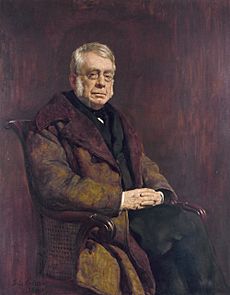
George and Richarda Airy had nine children. Sadly, their first three children died young. Their daughter Elizabeth died from tuberculosis. Their son Wilfrid became an engineer. He designed an observatory. Another son, Hubert, was a doctor. He studied migraine headaches, which Airy himself suffered from. Their daughter Hilda married a mathematician.
Airy was made a knight in 1872. So, he became "Sir George Biddell Airy."
He retired in 1881. He lived with his two unmarried daughters. In 1891, he fell and was badly hurt. He died a few days after surgery. He is buried with his wife and children in Playford, Suffolk.
Some people say that the ghost of Airy has been seen at the Royal Greenwich Observatory at night!
Airy's Legacy and Honours
Sir George Biddell Airy was a very important scientist. Many things are named after him:
- He was president of the Royal Astronomical Society four times. No one else has been president more often.
- He was a member of many important scientific groups around the world.
- The Airy crater on Mars is named for him. Inside it is a smaller crater called Airy-0. This crater marks the prime meridian of Mars.
- There is also a crater on the Moon named after him.
- The Airy functions in mathematics are named in his honour.
- The Airy disc (the light pattern seen through a telescope) is named after him.
See also
 In Spanish: George Biddell Airy para niños
In Spanish: George Biddell Airy para niños


